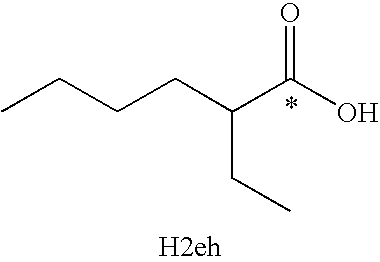Ionic liquids
a technology of ionic liquids and liquids, applied in the field of ionic liquids, can solve the problems of limiting the practical use of solvents, reducing the solubility of such compounds, and reducing the number of ionic liquids. the effect of reducing the volatility of such compounds
- Summary
- Abstract
- Description
- Claims
- Application Information
AI Technical Summary
Benefits of technology
Problems solved by technology
Method used
Image
Examples
example 1
[0028] In order to circumvent the problems associated with preparing metal 2-ethylhexanoates by conventional routes, samples were prepared using ion-exchange chromatography. Using a strongly basic anion exchange resin, a series of metal 2-ethylhexanoates were prepared in analytically pure form using a strongly basic ion exchange resin (Lewatit Monoplus MP 500). The resin was received in the Cl− form, and was converted to the OH− form by soaking in 1M NaOH for ˜2 hours. The resin was checked for residual Cl− by adding a portion of the supernatant to a silver nitrate solution, with a white precipitate indicating residual chloride. Additional soaking in NaOH was continued until no Cl− was detected. The resin was then washed with water and soaked in a 1 M H2eh / MeOH solution. A Pyrex Michel-Miller column 300 mm in length and with a 15 mm ID was filled with resin that was previously soaked in a 1 M solution of 2-ethylhexanoic acid in methanol. The column was then rinsed with methanol for ...
example 2
[0038] Using the ion exchange procedure described in Example 1, choline 2-ethylhexanoate (ch(2eh).xH2O) and ethylenediamene 2-ethylhexanoate (H2en(2eh)2) were also prepared. Characteristics of these compounds are as follows:
[0039] ch(2eh).x H2O Prepared by ion exchange. EA Found (Calc. for C13H29O3N.0.7H2O): C, 60.11(60.10), H, 11.89 (11.78). FTIR (KBr): 3197 (s, b), 3030 (s), 2964 (s), 2939 (s), 2875 (s), 2868 (s), 1583 (s), 1489 (s), 1467 (s), 1402 (s), 1315 (s), 1257 (w), 1211 (w), 1144 (m), 1095 (s), 1045 (m), 1011 (w), 960 (s), 924 (w), 893 (w), 870 (w), 806 (w), 775 (w), 737 (w), 677 (w), 640 (w), 561 (w) cm−1. 1H NMR (methanol-d4): δ=4.02 (m, 2H, CH2O), 3.52 (m, 3H, CH2N+R3), 3.35 (s, 1H, ROH), 3.24 (s, 9H, (CH3)3N+R), 2.10 (m, 1H, CH), 1.54 (m, 2H, CH2), 1.33 (m, 6H, CH2), 0.90 (m, 6H, CH3). 13C NMR (methanol-d4): δ=184.86 (COO), 69.17 (CH2NR3), 57.19 (CH2OH), 52.47 (CH), 34.31 (CH2), 31.74 (CH2), 27.65 (CH2), 24.12 (CH2), 14.70 (CH3), 13.11 (CH3).
[0040] H2en(2eh)2 A 100 mL...
example 3
[0048] Terephthalic acid is a chemical precursor for polyethyleneterephthalate (PET), a plastic commonly used, for example, in clear beverage bottles. Terephthalic acid is most commonly manufactured by oxidation of p-xylene in acetic acid, using flowing, pressurized air as the oxidizer. Typical reaction conditions are 200° C. at 15-30 atmospheres pressure of flowing air.
[0049] In this example, various conditions and reactants were run in a static air pressurized vessel. Reactants and conditions are given in the table below. Where no “P (psi)” given, air pressure is ambient.
Solvent (g)Reagent (g)Catalyst (g)T (° C.)P (psi)t (m)Zn(2eh)2HOAcH2Op-XyleneH2O2NaBrCo(2eh)2Mn(2eh)2% Yd2001201.683.622.020.109780.62001201.244.252.140.060520.52001006012.094.080.04050.01190.04634.22001201.184.020.05122.7200200606.092.011.040.02260.00290.01902.52001201.384.130.06370.03242.3200100604.2812.150.00840.00460.01661.8200100606.092.010.02180.03210.01421.7200100601.486.070.02740.01060.07040.81902006012...
PUM
| Property | Measurement | Unit |
|---|---|---|
| Temperature | aaaaa | aaaaa |
| Temperature | aaaaa | aaaaa |
| Temperature | aaaaa | aaaaa |
Abstract
Description
Claims
Application Information
 Login to View More
Login to View More - R&D
- Intellectual Property
- Life Sciences
- Materials
- Tech Scout
- Unparalleled Data Quality
- Higher Quality Content
- 60% Fewer Hallucinations
Browse by: Latest US Patents, China's latest patents, Technical Efficacy Thesaurus, Application Domain, Technology Topic, Popular Technical Reports.
© 2025 PatSnap. All rights reserved.Legal|Privacy policy|Modern Slavery Act Transparency Statement|Sitemap|About US| Contact US: help@patsnap.com

